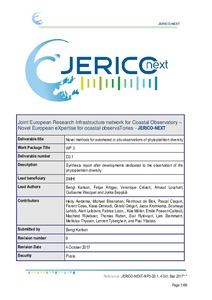| dc.contributor.author | Karlson, Bengt | |
| dc.contributor.author | Artigas, Felipe | |
| dc.contributor.author | Créach, Veronique | |
| dc.contributor.author | Louchart, Arnaud | |
| dc.contributor.author | Wacquet, Guilliaume | |
| dc.contributor.author | Seppälä, Jukka | |
| dc.date.accessioned | 2019-01-11T23:23:45Z | |
| dc.date.available | 2019-01-11T23:23:45Z | |
| dc.date.issued | 2017 | |
| dc.identifier.citation | Karlson, B.; Artigas, F.; Créach, V.; Louchart, A.; Wacquet , G. and Seppälä, J. (2017) Novel methods for automated in situ observations of phytoplankton diversity. WP.3, D3.1, Version 9. IFREMER for JERICO-NEXT, 69pp. ( JERICO-NEXT-WP3-D3.1). DOI: http://dx.doi.org/10.25607/OBP-219 | en_US |
| dc.identifier.uri | http://hdl.handle.net/11329/661 | |
| dc.identifier.uri | http://dx.doi.org/10.25607/OBP-219 | |
| dc.description.abstract | Phytoplankton forms the base of the marine food web. The number of phytoplankton taxa in the sea have been
estimated to be over 10 000. All of them are primary producers but the ecological function of the different taxa
varies. Many species can not only utilize light as an energy source but also feed on other organisms. Some of the
species are harmful, e.g. producing phycotoxins that may accumulate in sea food and pose a threat to human
health. Phytoplankton vary in size and shape; the size range is approximately 0.8 µm to 0.5 mm. Colonies of cells
may be a few mm in size. Traditionally phytoplankton is monitored by collecting water samples and analysing them
manually using microscopy. This is a good but labour-intensive method. The last few decades novel methodologies
have been developed to be able to process a much larger number of samples compared to microscopy and to do
it automated and autonomously. The novel methodologies include optical methods and also molecular biological
methods described in JERICO-NEXT deliverable 3.7 Progress report after development of microbial and molecular
sensors. An overview of current methods is presented in table 1. Remote sensing is outside the scope of JERICONEXT.
The aim of this report is to describe results from JERICO-NEXT on the development and evaluation of novel
methodology for observing phytoplankton in situ. There are three main approaches used:
1. Imaging in Flow systems (Imaging Flow Cytometry) - Describing the phytoplankton composition based on
morphology by imaging individual cells. Describing the plankton community imaging organisms and
colonies of cyanobacteria in the free water mass in situ.
2. Single-cell optical analysis (Pulse shape-recording Flow cytometry) - Describing the phytoplankton
composition based on the fluorescence properties (pigment content) and scattering properties of individual
cells.
3. Bulk optical approaches (multi-spectral Fluorescence or absorption/variable fluorescence) – describing
the phytoplankton community based on bulk properties: fluorescence or absorption of a large number of
cells. Multi wavelength approaches makes it possible to differentiate pigment groups of microalgae,
whereas variable fluorimetry addresses photosynthetic parameters and potential productivity. | en_US |
| dc.language.iso | en | en_US |
| dc.publisher | IFREMER for JERICO-NEXT | en_US |
| dc.relation.ispartofseries | JERICO-NEXT-WP3-D3.1; | |
| dc.title | Novel methods for automated in situ observations of phytoplankton diversity. WP.3, D3.1,Version 9. | en_US |
| dc.type | Report | en_US |
| dc.description.status | Published | en_US |
| dc.format.pages | 69pp. | en_US |
| dc.description.refereed | Refereed | en_US |
| dc.subject.parameterDiscipline | Parameter Discipline::Biological oceanography::Phytoplankton | en_US |
| dc.description.currentstatus | Current | en_US |
| dc.description.eov | Phytoplankton biomass and diversity | en_US |
| dc.description.bptype | Guide | en_US |
| obps.resourceurl.publisher | http://www.jerico-ri.eu/download/jerico-next-deliverables/JERICO-NEXT-Deliverable-3.1_V9.pdf | en_US |
 Repository of community practices in Ocean Research, Applications and Data/Information Management
Repository of community practices in Ocean Research, Applications and Data/Information Management
